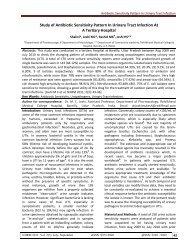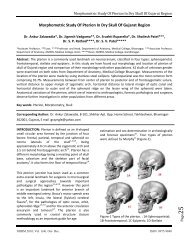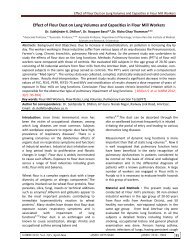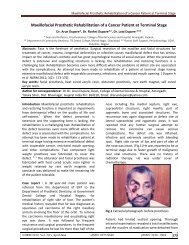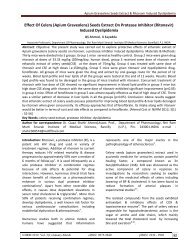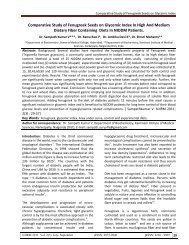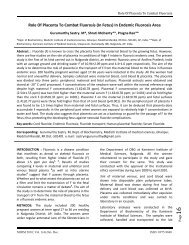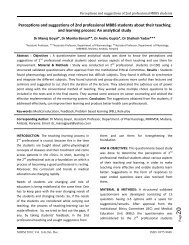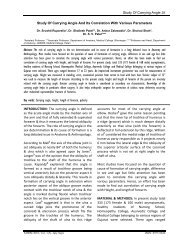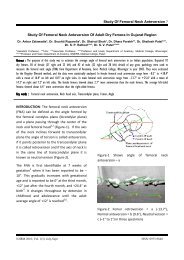Menstrual Pattern of Adolescent School Girls of Bhavnagar (Gujarat)
Menstrual Pattern of Adolescent School Girls of Bhavnagar (Gujarat)
Menstrual Pattern of Adolescent School Girls of Bhavnagar (Gujarat)
Create successful ePaper yourself
Turn your PDF publications into a flip-book with our unique Google optimized e-Paper software.
Page38<br />
<strong>Menstrual</strong> <strong>Pattern</strong> Of <strong>Adolescent</strong> <strong>School</strong> <strong>Girls</strong><br />
<strong>Menstrual</strong> <strong>Pattern</strong> <strong>of</strong> <strong>Adolescent</strong> <strong>School</strong> <strong>Girls</strong> <strong>of</strong> <strong>Bhavnagar</strong> (<strong>Gujarat</strong>)<br />
Dr. P.B. Verma*, Dr. C.M. Pandya**, Dr. V.A. Ramanuj***, Dr. M.P. Singh****<br />
*Pr<strong>of</strong>essor & Head, Department <strong>of</strong> P.S.M., P.D.U. Medical College, Rajkot, **Assistant Pr<strong>of</strong>essor, Department <strong>of</strong> P.S.M., Govt. Medical<br />
College, Baroda,***Tutor, ****Pr<strong>of</strong>essor, Department <strong>of</strong> P.S.M., Medical College, <strong>Bhavnagar</strong>. India<br />
Abstract: Background: Menstruation is a normal physiological phenomenon for females indicating her<br />
capability for procreation. However this normal <strong>of</strong>ten associated with some degree <strong>of</strong> sufferings and<br />
embarrassment. The prevalence <strong>of</strong> menstrual disorders has been recorded as high as 87 % though there is a<br />
relative openness in the society as well as commercialization has increased, the menstrual hygienic practices<br />
have not changed much. Mostly it is because <strong>of</strong> a sense <strong>of</strong> hesitation and to an extent, because <strong>of</strong> financial<br />
restraints. Present study was carried in this line to find out problems. Aims and Objectives: To find out the age<br />
<strong>of</strong> menarche <strong>of</strong> girls and to know menstrual pattern and menstrual hygiene practice & to find out the prevalence<br />
and types <strong>of</strong> menstrual disorders. Materials and Methods: Present cross sectional study was carried out at Govt.<br />
High school <strong>of</strong> <strong>Bhavnagar</strong> city. Total 745 <strong>Adolescent</strong> school girls were interviewed by trained female interns<br />
Information was obtained in a self administered pr<strong>of</strong>orma in a local language related to age <strong>of</strong> menarche, total<br />
days <strong>of</strong> bleeding, regularity <strong>of</strong> cycle, menstrual hygiene and menstrual problems after verbal consent. Results:<br />
The mean age <strong>of</strong> menarche was found to be about 14 (13.99, S.D. 1.8). Most <strong>of</strong> the girls (88.1%) had the prior<br />
information about menstruation before the occurrence <strong>of</strong> the event. The most common menstrual pattern was<br />
30/3-5 days. The most common menstrual disorder was dysmenorrhea (50.6%), followed by irregular<br />
menstruation (22.9%). Most <strong>of</strong> the girls (87.3 %) used old plain cloth as menstrual absorbent. Conclusion:<br />
<strong>Adolescent</strong> girls should be made educated about normal physiology <strong>of</strong> menstruation and menstrual hygiene at<br />
schools.<br />
Key-words: <strong>Adolescent</strong> girls, Dysmenorrhea, menarche, menstrual hygiene, menstrual disorders, school girls<br />
Corresponding Author: Dr. P.B. Verma, 20, Devmangalya Bungalows, B/h H.P. Petrol Pump, Motera, Ahmedabad<br />
- 380 005, Email: drpramodverma@rediffmail.com<br />
INTRODUCTION: Menstruation is a normal<br />
physiological phenomenon for females indicating her<br />
capability for procreation. However this normal<br />
phenomenon is not an easy one. It is <strong>of</strong>ten associated<br />
with some degree <strong>of</strong> sufferings and embarrassment. It<br />
is common observation that every woman does<br />
experience one or other type <strong>of</strong> menstrual problems<br />
in her lifetime. The prevalence <strong>of</strong> menstrual disorders<br />
has been recorded as high as 87 % 1 .<br />
It is a common observation that girls are rarely<br />
informed about menstruation unless they<br />
experience it for the first time. It is mostly a<br />
traumatic experience for them. If the girls are well<br />
informed about menstruation, well in advance, it<br />
will help them in the life later on. Though there is a<br />
relative openness in the society as well as<br />
commercialization has increased, the menstrual<br />
hygienic practices have not changed much. Mostly it<br />
is because <strong>of</strong> a sense <strong>of</strong> hesitation and to an extent,<br />
because <strong>of</strong> financial restraints.<br />
The present study was planned to find out the<br />
menstrual pattern <strong>of</strong> girls in this region, as well as<br />
their menstrual hygienic practices. It was also tried<br />
to find out the prevalence <strong>of</strong> menstrual disorders<br />
and their types. Present Study was undertaken 1.<br />
To find out the age <strong>of</strong> menarche among the girls <strong>of</strong><br />
this region 2. To know the menstrual pattern and<br />
menstrual hygiene practice.3. To find out the<br />
prevalence and types <strong>of</strong> menstrual disorders.<br />
MATERIAL AND METHODS: This is cross sectional<br />
study carried out among 745 high school girls <strong>of</strong><br />
<strong>Bhavnagar</strong> city. The data were collected by female<br />
intern doctors. All the interns were trained for data<br />
collection, data entry and analysis. The pr<strong>of</strong>orma<br />
was prepared in <strong>Gujarat</strong>i language so to make it<br />
NJIRM 2011; Vol. 2(1).Jan-March eISSN: 0975-9840 pISSN: 2230 - 9969
Page39<br />
<strong>Menstrual</strong> <strong>Pattern</strong> Of <strong>Adolescent</strong> <strong>School</strong> <strong>Girls</strong><br />
understand easily by girls. The pr<strong>of</strong>orma was semistructured.<br />
The pr<strong>of</strong>orma was self-administered,<br />
however female intern doctors were present to<br />
remove the inhibitions and provide the<br />
clarification <strong>of</strong> doubts if any and verbal consent<br />
was taken. The pr<strong>of</strong>orma contained the questions<br />
related to age <strong>of</strong> menarche, pattern <strong>of</strong><br />
menstruation in the form <strong>of</strong> inter-menstrual gap,<br />
total days <strong>of</strong> bleeding, regularity <strong>of</strong> cycle. An<br />
enquiry was also made to know menstrual related<br />
problems like dysmenorrhea, menorrhagia, etc. It<br />
was also tried to find out menstrual hygienic<br />
practices among them.<br />
RESULTS : Information about menstruation:<br />
Interestingly 88.1% girls had had the information<br />
about the menstruation before they achieved the<br />
menarche. Remaining girls were not informed<br />
about menses. The main source <strong>of</strong> information was<br />
mother (57.2%). An important finding was that in a<br />
girls' school, only 1.7 % girls got the information<br />
from their teacher. Other sources were elder<br />
sister, relatives, friends and books.<br />
Table 1: Information Regarding <strong>Menstrual</strong> Cycle.<br />
Information Number <strong>of</strong><br />
<strong>Girls</strong><br />
Percentage<br />
(n=745)<br />
Yes 656 88.1<br />
No 60 8.1<br />
Not Stated 29 3.9<br />
Total 745 100.0<br />
Table 2: Source <strong>of</strong> Information Regarding<br />
<strong>Menstrual</strong> Cycle.<br />
Source Number <strong>of</strong> <strong>Girls</strong> Percent<br />
age<br />
(n=745)<br />
Mother 426 57.2<br />
Sister 122 16.4<br />
Teacher 13 1.7<br />
Friend 78 10.5<br />
Books 11 1.5<br />
Others 4 0.5<br />
Not Stated 91 12.2<br />
Total 745 100.0<br />
Menarche & <strong>Menstrual</strong> pattern: Out <strong>of</strong> total 745<br />
girls, 20 girls didn’t achieve the menarche at the<br />
time <strong>of</strong> study. Out <strong>of</strong> remaining 725 girls, 8 girls<br />
didn’t state their age <strong>of</strong> menarche; so as per<br />
records from 725 responses, the mean age <strong>of</strong><br />
menarche came to 13.995 (S.D. 1.8). Range <strong>of</strong> age<br />
<strong>of</strong> menarche was 12- 14.6 years<br />
TABLE 3: Duration <strong>of</strong> Menstruation.<br />
Duration Number <strong>of</strong><br />
<strong>Girls</strong><br />
Percentag<br />
e<br />
(n=725)<br />
Page40<br />
<strong>Menstrual</strong> <strong>Pattern</strong> Of <strong>Adolescent</strong> <strong>School</strong> <strong>Girls</strong><br />
<strong>Menstrual</strong> hygiene: Majority <strong>of</strong> girls (87.3%) used<br />
old plain cloth during menstruation and only 10.6<br />
% used commercially available sanitary napkins.<br />
Remaining 13 (1.8%) girls didn’t respond to this<br />
question<br />
Table 5: <strong>Menstrual</strong> Hygiene<br />
Use<br />
Number <strong>of</strong><br />
<strong>Girls</strong><br />
Percenta<br />
ge<br />
(n=725)<br />
Cloth 633 87.3<br />
Sanitary<br />
77 10.6<br />
Pads<br />
Others 2 0.3<br />
Not Stated 13 1.8<br />
Total 725 100.0<br />
DISCUSSION: Our study suggested that 88.1% girls<br />
were informed about menstruation. The main<br />
source <strong>of</strong> information was the mother <strong>of</strong> the girl.<br />
However it was interesting to note that only 1.7%<br />
girls obtained the information from their teachers.<br />
The reason behind this may be that though it is a<br />
girl’s school, about half <strong>of</strong> the teachers are male.<br />
At the same time, even female teachers may feel<br />
embarrassed talking on this topic. The mean age <strong>of</strong><br />
menarche in our study was found to be 13.995<br />
(S.D. 1.8). The results are almost same as by Singh<br />
M.M. et al 2 . In their study, the mean age <strong>of</strong><br />
menarche was 13.6. In another study in rural<br />
Orissa, the mean age <strong>of</strong> menarche was found to be<br />
12.97 (S.D. 0.99) 3 . Although menarche is an<br />
occasion for celebration in south India, particularly<br />
in Tamilian people, the girls are rarely informed<br />
about it there also; very little information is given<br />
to young girls about the physiological processes<br />
involved and hygienic practices to be followed 1 .<br />
The most common menstrual problem was<br />
dysmenorrhea (50.6%), followed by irregular<br />
menses (22.9%). Though the dysmenorrhea was<br />
common, out <strong>of</strong> those 367 who had it, only 22.6%<br />
sought for help either to a doctor or their mother.<br />
Remaining accepted it as their destiny. Other<br />
studies have also found the dysmenorrhea the<br />
most common menstrual disorder 4, 5 . It was<br />
amazing to note that still most <strong>of</strong> the girls (87.3%)<br />
use old plain cloth as absorbent during<br />
menstruation and only 10.6% use commercially<br />
available sanitary napkins. However it was<br />
not clear, whether the reason for this was their<br />
economic status or just their hesitation.<br />
CONCLUSION AND RECOMMENDATION: <strong>Girls</strong><br />
should be informed well in advance about the<br />
menstruation, physiological process involved, its<br />
importance etc. Mothers are primarily responsible<br />
for the transmission <strong>of</strong> such type <strong>of</strong> information.<br />
This will help the girls to take it positively. Hygiene<br />
during menstruation should be maintained, so to<br />
avoid any reproductive tract infection. Teachers’<br />
role for the transmission <strong>of</strong> information.<br />
ACKNOWLEDGEMENTS: We are highly thankful to<br />
principal and teachers <strong>of</strong> the school for the<br />
providing permission and support to conduct the<br />
study. We also acknowledge all the girls who<br />
participated in this study.<br />
REFERENCES:<br />
1. Narayan K.A. et al: “Puberty Rituals,<br />
Reproductive Knowledge and Health <strong>of</strong><br />
<strong>Adolescent</strong> <strong>School</strong>girls in South India.”, Asia<br />
Pacific Population Journal, Vol. 16, No. 2, 224-<br />
236.<br />
2. Singh M.M. et al “Awareness and health<br />
seeking behaviour <strong>of</strong> rural adolescent school<br />
girls on menstrual and reproductive health<br />
problems”, I.J.M.R., 1999. Vol. 53, Issue 10,<br />
439-43.<br />
3. Dutta Himansu Sekhar, “Sexual health status <strong>of</strong><br />
adolescent girls in rural Orissa”,<br />
http://www.orissavha.org/studies/shstudy/20<br />
2001-2.doc<br />
4. Drakshayani Devi K. et al “A study on<br />
menstrual hygiene among rural adolescent<br />
girls”, IJMS, 1994 Vol. 48 Issue 6,139-43<br />
5. Ganguly Mukherjee Gita et al “Knowledge <strong>of</strong><br />
Reproductive Health Issues among the <strong>School</strong><br />
going Teenagers <strong>of</strong> Rural Bengal”, J. Obst.<br />
Gyne. India, Vo. 41, No. 1: Jan/Feb. 2001,115-<br />
118<br />
NJIRM 2011; Vol. 2(1).Jan-March eISSN: 0975-9840 pISSN: 2230 - 9969



